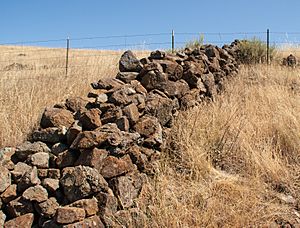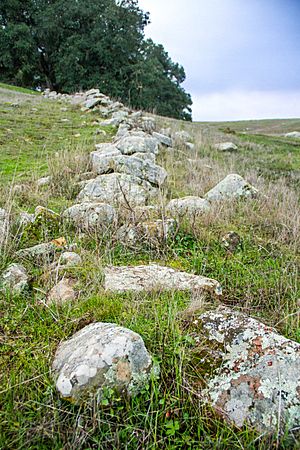East Bay Walls facts for kids
The East Bay Walls are also sometimes called the Berkeley Mystery Walls. However, this name isn't quite right. There are many similar stone walls all over the hills around the San Francisco Bay Area. These walls even reach as far north as Chico and Red Bluff, California.
These walls are built without any mortar, which is the cement-like material that usually holds bricks or stones together. They can be about a meter (around 3 feet) high and a meter wide. The walls are not one long line. Instead, they appear in sections. Some sections are just a few meters long, while others stretch for over half a mile.
The rocks used to build these walls come in many different sizes. Some are as small as a basketball. Others are huge sandstone boulders that can weigh a ton or more! In some places, the walls look like simple piles of rocks. But in other spots, they seem to have been carefully put together.
No one knows exactly how old these walls are. However, they look very ancient. Many parts of the walls have sunk deep into the ground. They are often completely covered by plants and trees. This makes them even more mysterious!
Contents
Why Were the Walls Built?
The stone walls are not continuous. They are made of many separate sections. This means they were probably not used as fences. Also, they are not tall enough to have been used for defense. They couldn't have protected people from attackers.
The East Bay Regional Park District calls them "rock walls." They say the walls are not really mysterious. They believe there's a simple reason for them.
For a long time, livestock, like cattle, have grazed in the hills of the East and South Bay Area. This has been happening since European settlers first arrived. Farmers needed to clear scattered rocks from the land. This made it easier for their animals to move around. Putting these rocks into walls would have helped. The walls could have guided the animals or helped to gather them into pens.
Who Built the Walls?
No one has found any written records about these walls. We don't know when they were built, who built them, or why. This is part of their mystery.
Some people once thought that the Ohlone people built them. The Ohlone were Native Americans who lived in this area. However, the Ohlone were hunter-gatherers. They moved around to find food. They are not known for building permanent structures like these walls.
Newer tests have looked at the lichen growing on the rocks. Lichen are tiny plant-like growths. Scientists can use them to estimate how old a surface is. These tests suggest the walls were likely built between 1850 and 1880. This was during the early American era in California.
It's possible that settlers built the walls. They might have used laborers from different groups. These could have included Chinese, Mexican, or Native American workers. But exactly who built them is still not known for sure.
Where Can You See the Walls?
You can find these stone walls in several parks around the area. Some of these parks include Ed R. Levin County Park in Santa Clara County. You can also see them at Mission Peak Regional Preserve in Alameda County. They are present in many other parks too.
Studying the Walls
Since 2016, an archaeologist named Jeffrey Fentress has been studying the walls. He is carefully measuring and mapping them. His goal is to help protect these historical structures. This would prevent them from being destroyed by new buildings or other changes.
Other stone walls with unknown origins are found near the San Francisco Bay. Researchers are still working to discover more information about these mysterious walls.
Images for kids





